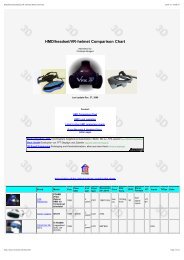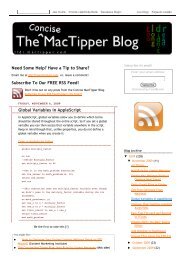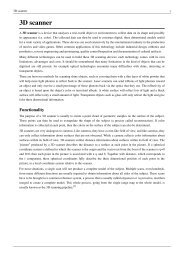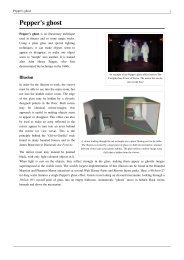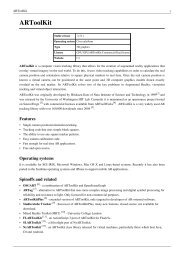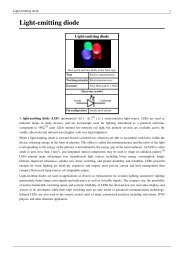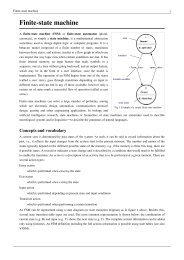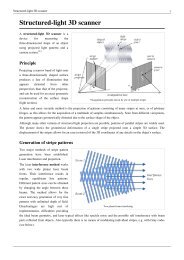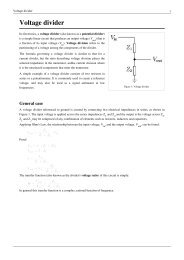LIDAR - Wikipedia, the free encyclopedia.pdf - Ex-ch.com
LIDAR - Wikipedia, the free encyclopedia.pdf - Ex-ch.com
LIDAR - Wikipedia, the free encyclopedia.pdf - Ex-ch.com
You also want an ePaper? Increase the reach of your titles
YUMPU automatically turns print PDFs into web optimized ePapers that Google loves.
<strong>LIDAR</strong> 6<br />
Military and law enforcement<br />
One situation where <strong>LIDAR</strong> has notable non-scientific application is in<br />
traffic speed enforcement, for vehicle speed measurement, as a<br />
te<strong>ch</strong>nology alternative to radar guns. The te<strong>ch</strong>nology for this<br />
application is small enough to be mounted in a hand held camera "gun"<br />
and permits a particular vehicle's speed to be determined from a stream<br />
of traffic. Unlike RADAR whi<strong>ch</strong> relies on doppler shifts to directly<br />
measure speed, police lidar relies on <strong>the</strong> principle of time-of-flight to<br />
calculate speed. The equivalent radar based systems are often not able<br />
to isolate particular vehicles from <strong>the</strong> traffic stream. <strong>LIDAR</strong> has <strong>the</strong><br />
distinct advantage of being able to pick out one vehicle in a cluttered<br />
traffic situation as long as <strong>the</strong> operator is aware of <strong>the</strong> limitations<br />
imposed by <strong>the</strong> range and beam divergence.<br />
Police officer using a hand-held <strong>LIDAR</strong> speed<br />
<strong>LIDAR</strong> does not suffer from “sweep” error when <strong>the</strong> operator uses <strong>the</strong> equipment correctly and when <strong>the</strong> <strong>LIDAR</strong> unit<br />
is equipped with algorithms that are able to detect when this has occurred. A <strong>com</strong>bination of signal strength<br />
monitoring, receive gate timing, target position prediction and pre-filtering of <strong>the</strong> received signal wavelength<br />
prevents this from occurring. Should <strong>the</strong> beam illuminate sections of <strong>the</strong> vehicle with different reflectivity or <strong>the</strong><br />
aspect of <strong>the</strong> vehicle <strong>ch</strong>anges during measurement that causes <strong>the</strong> received signal strength to be <strong>ch</strong>anged <strong>the</strong>n <strong>the</strong><br />
<strong>LIDAR</strong> unit will reject <strong>the</strong> measurement <strong>the</strong>reby producing speed readings of high integrity. For <strong>LIDAR</strong> units to be<br />
used in law enforcement applications a rigorous approval procedure is usually <strong>com</strong>pleted before deployment. The<br />
use of many reflections and an averaging te<strong>ch</strong>nique in <strong>the</strong> speed measurement process increase <strong>the</strong> integrity of <strong>the</strong><br />
speed reading. Vehicles are usually equipped with a horizontally oriented registration plate that, when illuminated,<br />
causes a high integrity reflection to be returned to <strong>the</strong> <strong>LIDAR</strong> - despite <strong>the</strong> shape of <strong>the</strong> vehicle. In locations that do<br />
not require that a front or rear registration plate is fitted, headlamps and rear-reflectors provide almost ideal<br />
retro-reflective surfaces over<strong>com</strong>ing <strong>the</strong> reflections from uneven or non-<strong>com</strong>pliant reflective surfaces <strong>the</strong>reby<br />
eliminating “sweep” error. It is <strong>the</strong>se me<strong>ch</strong>anisms whi<strong>ch</strong> cause concern that <strong>LIDAR</strong> is somehow unreliable.<br />
Most traffic <strong>LIDAR</strong> systems send out a stream of approximately 100 pulses over <strong>the</strong> span of three-tenths of a<br />
second. A "black box" proprietary statistical algorithm picks and <strong>ch</strong>ooses whi<strong>ch</strong> progressively shorter reflections to<br />
retain from <strong>the</strong> pulses over <strong>the</strong> short fraction of a second.<br />
Few military applications are known to be in place and are possibly classified, but a considerable amount of resear<strong>ch</strong><br />
is underway in <strong>the</strong>ir use for imaging. Higher resolution systems collect enough detail to identify targets, su<strong>ch</strong> as<br />
tanks. Here <strong>the</strong> name LADAR is more <strong>com</strong>mon. <strong>Ex</strong>amples of military applications of <strong>LIDAR</strong> include <strong>the</strong> Airborne<br />
Laser Mine Detection System (ALMDS) for counter-mine warfare by Arete Associates [22] .<br />
Utilizing <strong>LIDAR</strong> and THz interferometry wide area raman spectroscopy, it is possible to detect <strong>ch</strong>emical, nuclear, or<br />
biological threats at a great distance. Fur<strong>the</strong>r investigations regarding long distance and wide area spectroscopy are<br />
currently conducted by Sandia National Laboratories.<br />
Five <strong>LIDAR</strong> units produced by <strong>the</strong> German <strong>com</strong>pany Sick AG were used for short range detection on Stanley, <strong>the</strong><br />
autonomous car that won <strong>the</strong> 2005 DARPA Grand Challenge.<br />
A robotic Boeing AH-6 performed a fully autonomous flight in June 2010, including avoiding obstacles using<br />
[23] [24]<br />
<strong>LIDAR</strong>.<br />
gun





